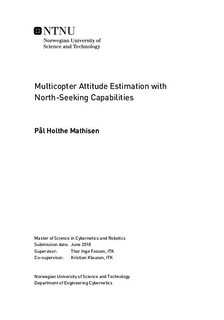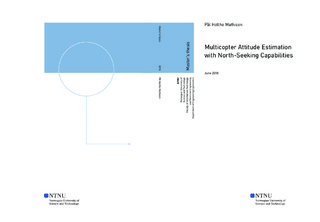| dc.description.abstract | This thesis deals with attitude measurement by fusing sensor information from accelerometers, gyros and position aiding in the form of a pseudorange measurement system, on a multicopter system. This is motivated by multicopter being highly accelerated systems, meaning that the acceleration vector is a reliable choice for heading measurements. Estimation of roll and pitch using the gravity vector in a non-accelerated environment is also tested. The sensor fusion is mostly done on data from a simulated multicopter, meaning that nothing could directly be said about the heading angle from knowledge of the vehicle's velocity in the body-frame. Three different approaches to the heading measurements is investigated, all which performs an averaging of the heading measurements over specific time intervals to minimize random deviations from the true value. The methods all compare the acceleration vector from the accelerometer measurements, compensated for roll and pitch, with either the actual acceleration vector or a substitute, in NED-frame obtained by the position aiding system. The achieved accuracy of the best averaged measurement method in the simulated environment is on average $0.21^{\circ}$. The best results for the method not dependent on initial conditions and specific motion achieves an averaged accuracy of $3.26^{\circ}$. The simulated results were found through the use of the Monte Carlo method.
Experimental results from real multicopter flight data were less promising. The best results showed about $7^{\circ}-8^{\circ}$, and are not surprisingly from the method requiring no additional conditions, as a real manual flight has less control of the motion than an autopilot.
The thesis concludes that all methods require a sufficient level of acceleration to observe the heading with any accuracy. Since high acceleration is required reliable heading, while low acceleration is required for reliable roll and pitch, the two measurements should not be performed at the same time.
The method of finding the time interval over which to average the heading measurements should also be improved further, as significant errors occur at non-zero heading angles for the current setup. | en |

